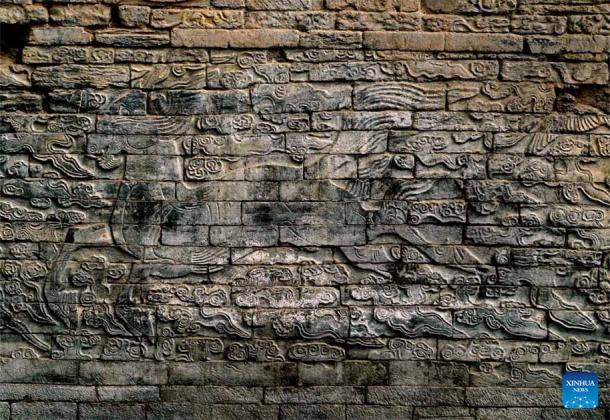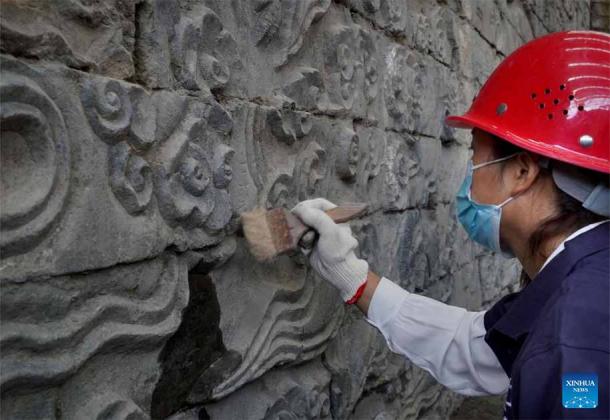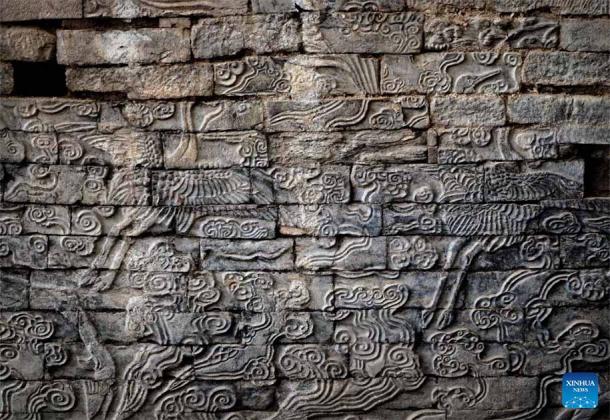
Huge, Exquisite, Song Dynasty Stone Murals Found in China
Two massive stone mural carvings dating to the Northern Song dynasty (960-1127 AD) that were found in central China’s Henan province have been hailed by archaeologists as a remarkable discovery. These are the largest such carvings to be found in China.
State media agency Xinhua reports that the carvings were found at the Zhouqiao archaeological site in Kaifeng city. They are distributed along the northern and southern banks of the eastern end of Zhouqiao Bridge.
Zhouqiao Archaeological Site, where Song Dynasty murals were found
The Zhouqioao Archaeological Site is named after Zhouqiao Bridge, built between 780 and 783 AD across the Grand Canal, an extensive waterway linking the northern and southern parts of China. The bridge was constructed under the Tang Dynasty (618-907 AD). It was an important landmark in central Kaifeng until 1642, when it was buried due to the flooding of the Yellow River.
According to the People’s Daily, archaeological work at the site began in 2018, and four years of digging have led to many exciting discoveries. The agency quotes Liu Haiwang, head of the Henan Provincial Institute of Cultural Relics and Archaeology as saying that the site has revealed copious remains in the form of bridges, waterways, embankments, temples, residences, and roads, as well as shipwrecks.
So far, a total of 4,400 square meters (47,361 square feet) of the site has been excavated, and remains and relics have been found at 117 sites. A whopping 60,000 artifacts have been found so far, of which as many as 56,000 are delicate porcelain pieces. Artifacts discovered at the site shed important light on canal trade and shipping, the development of the porcelain industry, north-south exchange, and social and commercial development in ancient China.
- The 2500-year-old Genius of China’s Grand Canal System
- The Tang Dynasty: The Arts Flourished, Family Ties Broke, and a Concubine Became Empress

Beautiful mural contains seahorses, clouds, cranes and more. (Xinhua)
The earliest remains in Kaifeng date to the Song Dynasty (960-1279 AD), with additional artifacts through the Qing Dynasty (1644-1911 AD). The city was built and rebuilt six times layer upon layer, as wars and flooding destroyed it repeatedly. “Bridges stacked on bridges and roads piled on roads, they form a spectacle of ‘layered cities’ in Kaifeng,” Liu is quoted by the Xinhua News Agency as saying.
The more or less intact structure of the Zhouqiao Bridge found by archaeologists belongs to the Ming Dynasty (1368-1644 AD), while the stone-cut engravings upon its walls belong to the Northern Song era (960-1127 AD).
- Chinese Builders Discover Song Dynasty Tomb with Elaborate Decoration but Robbers Have Stolen the Rest
- The Jewels of the East: Top 8 Ancient Capitals of China

A staff member cleans a stone mural discovered in the Zhouqiao relic site in Kaifeng City, central China's Henan Province, Sept. 21, 2022. (Xinhua)
The Song Dynasty Murals: Stone seahorses, Clouds and Cranes
As the China Daily reports, the engravings are a gigantic 3.3 meters (10.8 feet) in height, while the length excavated so far of the Song dynasty mural on the southern bank is 23.2 meters (76 feet). The one on the northern bank is slightly smaller at 21.2 meters (69.5 feet). They are carved with traditional auspicious Chinese patterns, such as seahorses, clouds, and flying cranes.

Part of the Song Dynasty mural containing cranes. It looks like some bricks are out of place! (Xinhua)
Lead archaeologist Zhou Runshan was quoted in the China Daily as saying that this is only the tip of the iceberg. Further excavation and clean-up work is expected to reveal more of the murals on the east side of the bridge, and a similar length on the western end. The total length of a single mural carving will likely be around 30 meters (98.4 feet), while taken together, it is expected to reach about 100 meters (328 feet). The total carved area, it is estimated, will be around 400 square meters (1312 square feet) once excavation of the Song dynasty murals on both the east and west sides of the bridge has been completed.
These stone carvings are an important find and “are highly consistent with historical records, presenting the prosperity and magnificence of the capital city Dongjing back then,” Liu is quoted by the Xinhua News Agency as saying. He added that the Song dynasty murals provide insight on the remarkable architectural achievements and rich art of the period.
“In terms of scale, subject and style, the stone murals can represent the highest standards of the stonework system and the highest level of carving techniques during the Northern Song Dynasty. It is an important discovery that enriches and rewrites the art history of the Song Dynasty,” said Zheng Yan, a professor at Peking University's School of Arts, according to the People’s Daily.
The six layers of Kaifeng have given archaeologists abundant material, but by no means have they revealed all their secrets. The exquisite Song Dynasty stone murals on Zhouqiao Bridge alone have yet to be fully excavated and can be expected to throw new light on the Song Dynasty’s art, architecture and culture once work on them is complete. The ongoing excavation of the city’s layered history will continue to reveal exciting discoveries.
Top image: A staff member cleans a Song dynasty mural discovered in the Zhouqiao relic site in Kaifeng City, central China's Henan Province. Source: Xinhua
By Sahir Pandey
References
Huge Ancient Stone Murals discovered in Central China. September 29, 2022. China Daily. Available at: https://govt.chinadaily.com.cn/s/202209/29/WS6334f6fd498ea274927a4964/huge-ancient-stone-murals-discovered-in-central-china.html.
Huge Ancient Stone Murals discovered in Central China. September 29, 2022. People’s Daily. Available at: http://en.people.cn/n3/2022/0929/c90000-10153155.html?fbclid=IwAR3Eikx07hebKV85BvoGzZE_P0FUSgQtM2ILA0jKqU1-n2pmvxNyS4srya8.
Archaeological Findings reveal Evolution of Ancient Chinese City. September 28, 2022. Xinhua News Agency. Available at: https://english.news.cn/20220928/f4a511a022d94e8aab6a9de7aa017d52/c.html.
















Comments
A very important discovery, but their explanation is highly dubious in a number of ways:
1) Shipwrecks among the ruins suggests that the place was totally destroyed in one event. A normal shipwreck that far inland would not be left in place. If many were left in place, then we must assume mass death and destruction, with all or nearly all lives lost. Otherwise, there would have been a clean-up effort, and nothing like this would be found.
2) It’s very difficult to believe the Zhou Qiao (aka Zhaozhou) Bridge was built in that form in the 6th Century, sturdy enough to survive intact while being buried by a flood. More likely, it was built by the pre-Ice Age civilization, and was buried in sand and dust over many tens of thousands of years. Moreover, there are no other bridges like that built when they say that one was built.
3) And this one is just too crazy: “The city was built and rebuilt six times layer upon layer, as wars and flooding destroyed it repeatedly. “Bridges stacked on bridges and roads piled on roads, they form a spectacle of ‘layered cities’ in Kaifeng.” If they claim this, how do they expect anybody to take them seriously. That's obviously fiction.
What makes much more sense is that the ruins of the pre-Ice Age civilization were buried in sediment, possibly due to sandstorm fallout and/or glaciation, and later the top layer was resettled after the glaciers subsided, and they’re just now starting to dig down and find the lower layers. It was obviously an advanced civilization that was destroyed, possibly unrelated to the people who came later.
Nobody gets paid to tell the truth.